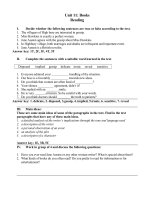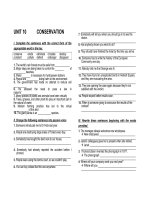Unit 10 conservation period 2 speaking
Bạn đang xem bản rút gọn của tài liệu. Xem và tải ngay bản đầy đủ của tài liệu tại đây (69.86 KB, 3 trang )
Nho Quan B high school
Phạm Hà Anh
Unit 10: Conservation
Period:
Period 2:
Speaking
I _ Objectives: By the end of the lesson, Ss will be able to:
- ask for someone’s opinion, and show their agreement or
disagreement about the new kind of zoo
- talk about the advantages and disadvantages of the new kind of
zoo
- report on discussion result
II _ Teaching aids: Textbook, pictures …..
III _ Anticipate problems: Ss may not know some words in the section, so T should be
ready to explain them.
IV _ Procedure:
Time
7’
Steps
Warm up and Check up
Work
arrangement
-T prepares 2 pictures of zoos: -1st one shows a traditional
Pair work
nd
zoo(animals are kept in cages); 2 one shows a new kind of
zoo(animals can live in their natural habitat)
- T asks Ss to work in pairs to describe the pictures:
+ What can you see in the first picture?
+ How might the animals feel?
+ What can you see in the second picture?
+ Are the animals in the 2nd picture free to run?
-> T introduces the new lesson: You are going to discuss the
new kind of zoo.
Task 1: Discussing the questions about the features of the
new kind of zoo.
Instruction: You are required to work in pairs to put the actions
in the order of importance and then say what we should or
should not do.
- T asks Ss to read through the 2 paragraphs.
- T gives and explains some new words:
1. Sensitive
/
/(adj): nhậy cảm
Whole class:
2. imprison
/
/ (v): bỏ tù, giam cầm (take notes)
3. Reconstruct/
/(v): xây dựng lại
4. Breed
/
/(v): gây giống, nhân
giống
5. Reintroduce/
/(v): đa về môi trờng
sống tự nhiên
- T asks Ss to work in pairs to discuss the 2 questions in the
Nho Quan B high school
Phạm Hà Anh
8
book, using the information in paragraph A and B
- T goes around to observe Ss working
- T asks some Ss to present their answers
- T gives feedback and correct answers:
1. They are opened to help endangered species develop.
2. The animals are not kept in cages. They can live in their
natural environment
Task 2: Showing the agreement or disagreement about the
new kind of zoo.
Instruction: Following are some ideas about the new kind of zoo
discuss in the task 1. You are required to show your agreement
or disagreement by ticking the right box. Then share your ideas
with a partner.
Structures:
Asking for opinion
+ What do you think of ….?
+ Do you think………?
+ Do you agree with…..?
Giving opinion
- I think……………….
- I don’t think…………
- In my opinion………….
Showing agreement
Showing agreement
+ I agree with…………
+ I don’t really think so.
+ Yes, I think you are right.
+ Yes… but…………
+ Exactly
+ I would doubt that…….
- T asks Ss to work individually to tick the suitable box to show
their agreement or disagreement
- T goes around to observe and offer help, taking notes of
students’ mistakes for later correction
- T calls on some Ss to talk about their ideas and ask other Ss to
add more.
- T gives feedback.
Task 3: Discussing the advantages and disadvantages of zoos
of the new kind
Instruction: You are going to discuss the advantages and
disadvantages of the new kind of the zoo using the cues
provided in the textbook.
- T asks Ss to work in groups to discuss the advantages and
disadvantages of the new kind of the zoo.
- T assign the group leader for each group to make sure that
group members work cooperatively and take notes of other
member’s point
- T goes round to observe and offers help.
- T takes notes of Ss’ mistakes for later correction.
Individual work
& pair work
Nho Quan B high school
Phạm Hà Anh
8
Task 4: Reporting on the discussion results
- T calls some Ss to report that their groups have discussed. T
asks other Ss to take notes and compare with their group’s
ideas.
FEEDBACK AND CORRECTION
- While Ss report, T takes notes of their errors. Then T gives
feedback on their answer.
- T correct any typical mistakes.
WRAPPING UP
- T summaries the main points.
- T asks Ss to do the extra activity as homework.
* Teacher’s reflection:
Whole class
Whole class
Whole class









